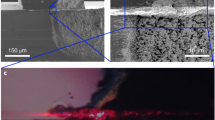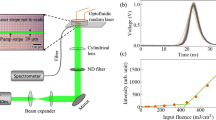Abstract
Random lasing — for which disorder is exploited to enhance stimulated emission — has emerged as a paradigmatic phenomenon of complex lasers. Random lasers feature unique properties such as tunable coherence and reconfigurable spectral emission. Nevertheless, their complexity sets them apart from conventional lasers, making it challenging to determine whether random lasing is occurring. In this Expert Recommendation, I discuss experimental methods required to properly assess and demonstrate random lasing action.
This is a preview of subscription content, access via your institution
Access options
Access Nature and 54 other Nature Portfolio journals
Get Nature+, our best-value online-access subscription
$29.99 / 30 days
cancel any time
Subscribe to this journal
Receive 12 digital issues and online access to articles
$99.00 per year
only $8.25 per issue
Buy this article
- Purchase on Springer Link
- Instant access to full article PDF
Prices may be subject to local taxes which are calculated during checkout

Similar content being viewed by others
References
Maiman, T. Stimulated optical radiation in ruby. Nature 187, 493–494 (1960).
Samuel, I. D. W., Namdas, E. B. & Turnbull, G. A. How to recognise lasing. Nat. Photonics 3, 546–549 (2009).
Cao, H. Review on latest developments in random lasers with coherent feedback. J. Phys. A Math. Gen. 38, 10497 (2005).
Lawandy, N. M., Balachandran, R. M., Gomes, A. S. L. & Sauvain, E. Laser action in strongly scattering media. Nature 368, 436–438 (1994).
Letokhov, V. S. Quantum statistics of multi-mode radiation from an ensemble of atoms. Sov. Phys. JETP 26, 1246–1251 (1968).
Luan, F. et al. Lasing in nanocomposite random media. Nano Today 10, 168–192 (2015).
Wiersma, D. S. & Lagendijk, A. Light diffusion with gain and random lasers. Phys. Rev. E 54, 4256–4265 (1996).
Oulton, R. F. et al. Plasmon lasers at deep subwavelength scale. Nature 461, 629–632 (2009).
Noginov, M. A. et al. Demonstration of a spaser-based nanolaser. Nature 460, 1110–1112 (2009).
Caixeiro, S., Gaio, M., Marelli, B., Omenetto, F. G. & Sapienza, R. Silk-based biocompatible random lasing. Adv. Opt. Mat. 4, 998–1003 (2016).
Humar, M. & Yun, S. H. Intracellular microlasers. Nat. Photonics 9, 572–576 (2015).
Schubert, M. et al. Lasing within live cells containing intracellular optical microresonators for barcode-type cell tagging and tracking. Nano Lett. 15, 5647–5652 (2015).
Bahari, B. et al. Nonreciprocal lasing in topological cavities of arbitrary geometries. Science 358, 636–640 (2017).
Bandres, M. A. et al. Topological insulator laser: experiments. Science 359, eaar4005 (2018).
Kodigala, A. et al. Lasing action from photonic bound states in continuum. Nature 541, 196–199 (2017).
Andreasen, J. et al. Modes of random lasers. Adv. Opt. Photonics 3, 88–127 (2011).
van der Molen, K. L., Mosk, A. P. & Lagendijk, A. Quantitative analysis of several random lasers. Opt. Commun. 278, 110–113 (2007).
Reeves, L., Wang, Y. & Krauss, T. F. 2D material microcavity light emitters: to lase or not to lase? Adv. Opt. Mater. 6, 1800272 (2018).
Glauber, R. J. Photon correlations. Phys. Rev. Lett. 10, 84–86 (1963).
Grynberg, G., Aspect, A., Fabre, C. & Cohen-Tannoudji, C. Complement 3C: Laser Light and Incoherent Light: Energy Density and Number of Photons per Mode 247–256 (Cambridge Univ. Press, 2010).
[No authors listed] Scrutinizing lasers. Nat. Photonics 11, 139 (2017).
Wiersma, D. S. The physics and applications of random lasers. Nat. Phys. 4, 359–367 (2008).
Gaio, M. et al. A nanophotonic laser on a graph. Nat. Commun. 10, 226 (2019).
Liu, J. et al. Random nanolasing in the Anderson localized regime. Nat. Nanotechnol. 9, 285–289 (2014).
Gottardo, S. et al. Resonance-driven random lasing. Nat. Photonics 2, 429–432 (2008).
Mujumdar, S., Ricci, M., Torre, R. & Wiersma, D. S. Amplified extended modes in random lasers. Phys. Rev. Lett. 93, 053903 (2004).
Ling, Y. et al. Investigation of random lasers with resonant feedback. Phys. Rev. A 64, 063808 (2001).
Türeci, H. E., Ge, L., Rotter, S. & Stone, A. D. Strong interactions in multimode random lasers. Science 320, 643–646 (2008).
Fallert, J. et al. Co-existence of strongly and weakly localized random laser modes. Nat. Photonics 3, 279–282 (2009).
Conti, C. & Fratalocchi, A. Dynamic light diffusion, three-dimensional Anderson localization and lasing in inverted opals. Nat. Phys. 4, 794–798 (2008).
Gaio, M., Peruzzo, M. & Sapienza, R. Tuning random lasing in photonic glasses. Opt. Lett. 40, 1611–1614 (2015).
Chow, W. W., Jahnke, F. & Gies, C. Emission properties of nanolasers during the transition to lasing. Light Sci. Appl. 3, e201 (2014).
Kreinberg, S. et al. Emission from quantum-dot high-β microcavities: transition from spontaneous emission to lasing and the effects of superradiant emitter coupling. Light Sci. Appl. 6, e17030 (2017).
Cao, H., Ling, Y., Xu, J. Y., Cao, C. Q. & Kumar, P. Photon statistics of random lasers with resonant feedback. Phys. Rev. Lett. 86, 4524–4527 (2001).
Papadakis, V. M. et al. Single-shot temporal coherence measurements of random lasing media. J. Opt. Soc. Am. B 24, 31–36 (2007).
Zacharakis, G., Papadogiannis, N. A., Filippidis, G. & Papazoglou, T. G. Photon statistics of laser like emission from polymeric scattering gain media. Opt. Lett. 25, 923–925 (2000).
Burgess, T. et al. Doping-enhanced radiative efficiency enables lasing in unpassivated GaAs nanowires. Nat. Commun. 7, 11927 (2016).
Marell, M. J. H. et al. Plasmonic distributed feedback lasers at telecommunications wavelengths. Opt. Express 19, 15109–15118 (2011).
Baudouin, Q., Mercadier, N., Guarrera, V., Guerin, W. & Kaiser, R. A cold-atom random laser. Nat. Phys. 9, 357–360 (2013).
García-Revilla, S. et al. Coherence characteristics of random lasing in a dye doped hybrid powder. J. Lumin. 169, 472–477 (2016).
Noginov, M. A., Egarievwe, S. U., Noginova, N., Caulfield, H. J. & Wang, J. C. Interferometric studies of coherence in a powder laser. Opt. Mater. 12, 127–134 (1999).
Redding, B., Choma, M. A. & Cao, H. Spatial coherence of random laser emission. Opt. Lett. 36, 3404–3406 (2011).
Ismail, W. Z. W. et al. Spectral and coherence signatures of threshold in random lasers. J. Opt. 16, 105008 (2014).
Wiseman, H. M. How many principles does it take to change a light bulb…into a laser? Phys. Scr. 91, 033001 (2016).
Bachelard, N., Gigan, S., Noblin, X. & Sebbah, P. Adaptive pumping for spectral control of random lasers. Nat. Phys. 10, 426–431 (2014).
Leonetti, M., Conti, C. & Lopez, C. The mode-locking transition of random lasers. Nat. Photonics 5, 615–617 (2011).
Saxena, D. et al. Mode profiling of semiconductor nanowire lasers. Nano Lett. 15, 5342–5348 (2015).
Kumar, R., Balasubrahmaniyam, M., Alee, K. S. & Mujumdar, S. Temporal complexity in emission from Anderson localized lasers. Phys. Rev. A 96, 063816 (2017).
Siddique, M., Alfano, R. R., Berger, G. A., Kempe, M. & Genack, A. Z. Time-resolved studies of stimulated emission from colloidal dye solutions. Opt. Lett. 21, 450–452 (1996).
Soukoulis, C. M., Jiang, X., Xu, J. Y. & Cao, H. Dynamic response and relaxation oscillations in random lasers. Phys. Rev. B 65, 041103(R) (2002).
van der Molen, K. L., Mosk, A. P. & Lagendijk, Ad Relaxation oscillations in long-pulsed random lasers. Phys. Rev. A 80, 055803 (2009).
García-Revilla, S. et al. Diffusive random laser modes under a spatiotemporal scope. Opt. Exp. 23, 1456–1469 (2015).
Zhu, G., Gu, L. & Noginov, M. A. Experimental study of instability in a random laser with immobile scatterers. Phys. Rev. A 85, 043801 (2012).
Ghofraniha, N. et al. Experimental evidence of replica symmetry breaking in random lasers. Nat. Commun. 6, 6058 (2015).
Uppu, R. & Mujumdar, S. Lévy exponents as universal identifiers of threshold and criticality in random lasers. Phys. Rev. A 90, 025801 (2014).
Cao, H., Chriki, R., Bittner, S., Friesem, A. A. & Davidson, N. Complex lasers with controllable coherence. Nat. Rev. Phys. 1, 156–168 (2019).
Bachelard, N., Andreasen, J., Gigan, S. & Sebbah, P. Taming random lasers through active spatial control of the pump. Phys. Rev. Lett. 109, 033903 (2012).
Genack, A. Z. & Drake, J. M. Scattering for super-radiation. Nature 368, 400–401 (1994).
Akkermans, E. & Montambaux, G. Mesoscopic Physics of Electrons and Photons (Cambridge Univ. Press, 2007).
Acknowledgements
The author thanks S. Caixeiro, S. Mujumdar and D. Saxena for useful discussions.
Author information
Authors and Affiliations
Corresponding author
Ethics declarations
Competing interests
The author declares no competing interests.
Additional information
Publisher’s note
Springer Nature remains neutral with regard to jurisdictional claims in published maps and institutional affiliations.
Reviewer information
Nature Reviews Physics thanks D. Wiersma and the other, anonymous, reviewer(s) for their contribution to the peer-review of this work.
Rights and permissions
About this article
Cite this article
Sapienza, R. Determining random lasing action. Nat Rev Phys 1, 690–695 (2019). https://doi.org/10.1038/s42254-019-0113-8
Accepted:
Published:
Issue Date:
DOI: https://doi.org/10.1038/s42254-019-0113-8
This article is cited by
-
A mode-locked random laser generating transform-limited optical pulses
Nature Communications (2024)
-
Tuning the efficiency of Random Laser Generation in a Suspension of ZnO Nanoparticles by Means of its Directional Freezing
Journal of Russian Laser Research (2023)
-
Electrically driven random lasing from a modified Fabry–Pérot laser diode
Nature Photonics (2022)
-
Self-organized lasers from reconfigurable colloidal assemblies
Nature Physics (2022)
-
Random lasing and replica symmetry breaking in GeO2-PbO-MgO glass–ceramics doped with neodymium
Scientific Reports (2022)



